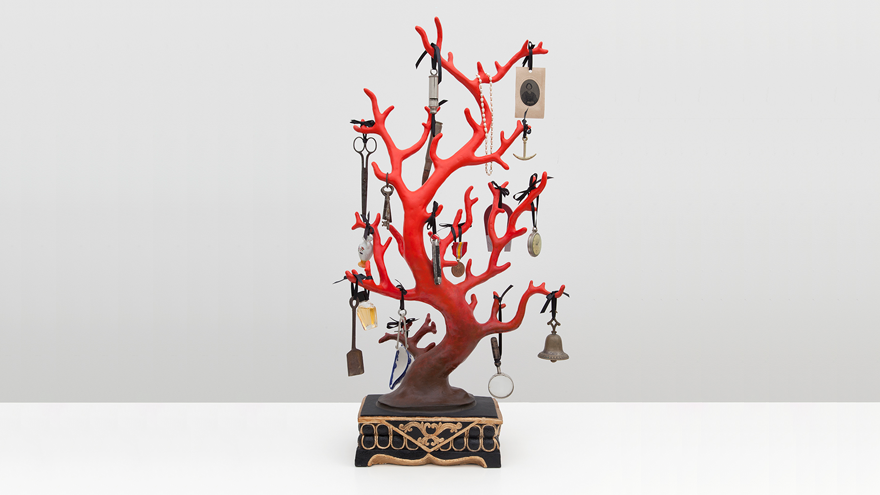On the first floor of the Middlebury College Museum of Art, in the alcove formed by the curved staircase that leads to the upstairs gallery, the charred, twisted remains of a tree root, or maybe trunk, rises five or six feet skyward. A dozen low blackened stumps surround it like supplicants praying to their idol. This is the 1988 “Imagem da minha revolta,” or “Image of My Revolt,” by the late Polish-born Brazilian artist Frans Krajcberg, and it offers the first glimpse of the museum’s current exhibit, Tossed: Art from Discarded, Found, and Repurposed Materials.
In this sculpture, Krajcberg has used burnt wood salvaged from the Amazon to express his outrage at the destruction of the rainforest. As I am about to find out, many of the materials used in this exhibit carry meaning that belies their lack of intrinsic value. Museum Designer Ken Pohlman ’78 says, “Most of the artists in this show do not shy away from having some sort of political comment to make.”
Pohlman walks me up the stairs to the exhibit, which he calls his “swan song”; after 37 years at the museum, he will retire in December. As his final project, this one is different, in that he both designed and curated it. “Usually, I’m the person who creates the physical space, the graphics, the wall color. This was my last go: I got to have my idea and my design.” The exhibit features 19 sculptures: a half dozen from the museum’s collection, a half dozen purchased, and the rest on loan from other institutions. Pohlman says the focus was on contemporary artists, many of them women, from around the globe.
Entering the gallery, we head left along the convex side of a high, curved wall that divides the room. The featured works are spaced well apart, each accompanied by a large wall-mounted quote from the artist. An oversized owl sculpted of twigs by Vermont artist Eben Markowski leads to a potted fabric cactus by Texan artist Margarita Cabrera. Its flat green segments are sewn from salvaged Border Patrol uniforms, on which immigrants to the U.S. have embroidered images and words—such as “DACA”—representing things for which they are grateful.
The materials in this exhibit include rusty scraps of metal, thrift-store baubles, chunks of wood, and more. While such found items might once have been limited to natural objects, Pohlman says, “in today’s throwaway society, there’s a lot more material to work with.” And the exhibit bears this out in pieces such as Khalil Chishtee’s nearly life-sized human sculptures made of used plastic grocery bags, and Duke Riley’s plastic jug—which he found washed up on the New York shoreline—faux-finished and inscribed to look like 18th-century scrimshaw.
Pohlman shows me one of the pieces that inspired the theme of the exhibit: a stylized African mask made from the upper part of a plastic gas can, whose handle juts from the wall. Next to it is a statement by Beninois artist Romuald Hazoumè: “The Europeans have taken away all of our masks and still they want more masks. In return, they have left us all their waste. So I recycle the rubbish which they send us every day, as masks for which they have such a hunger, and send it back, so that our old masks may stay with us.”
When we round the end of the curved dividing wall, the space opens up to reveal a massive piece by the Nigeria-based Ghanaian artist El Anatsui—the “rock star” of the exhibit, according to Pohlman. Affixed at various points to a dark lavender-gray wall, the undulating, quiltlike sculpture is by far the largest and most imposing work in the exhibit. Closer inspection reveals it to be made of hundreds—thousands—of flattened metal liquor bottle seals in reds, beiges, and grays, linked together with copper wire into a blanket of long color-blocked stripes.
Pohlman explains that the piece, on loan from the Hood Museum, measures 18 by 20 feet when laid out flat, and that the expansive area in front of it not only gives viewers room to appreciate its magnitude but also was necessary; the laborious and delicate process of attaching it to the wall required a lot of floor space, as well as the full 18 feet of the gallery’s ceiling height.
The resulting swags and undulations of the piece reflect Pohlman’s unique interpretation, which is encouraged by the artist. “He welcomes this to be different every time it’s installed,” Pohlman says.
He says the story goes that El Anatsui initially picked up a large bag of these discarded bottle seals on the side of the road but did nothing with them for several months. Eventually, he came up with the idea of assembling them in strips, in designs reminiscent of traditional Ghanaian kente cloth. Now his studio assistants collect the tags and wire them together into sections, which he arranges into vast sheets. And, of course, the medium holds meaning: “Liquor and rum played a role in the slave trade; that’s not lost on him,” Pohlman says.
After we’ve seen the last few pieces in the exhibit, I realize that my expectation going in—something along the lines of “One man’s trash is another man’s treasure”—was naïve. I did not anticipate how the artists would use such seemingly worthless materials to convey the weight of such big topics: racism, immigration, the crimes of colonialism, overconsumption, environmental devastation.
I’m a little embarrassed at having come in with such a simplistic perspective. But maybe my reaction after having seen the exhibit is exactly what Pohlman was hoping for when he designed and curated it. When I ask him what he wants visitors to take away from these works, he says, “Only that there’s no limit to creativity. I want people to see the power of material and how expressive it can be.”
Tossed: Art from Discarded, Found, and Repurposed Materials runs in the upstairs gallery of the Museum of Art through December 10.

Leave a Reply